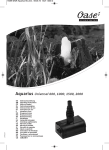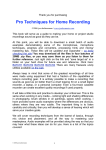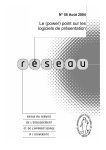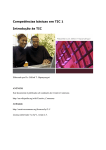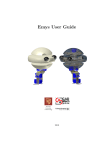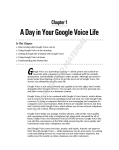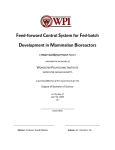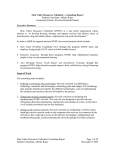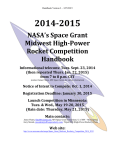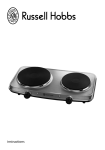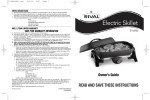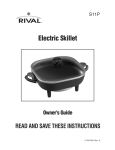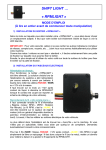Download File
Transcript
Acknowledgements This book was authored by Richardson High School AP Physics B students Amanda Gonzales, Dominique James, Jackie Slanley, Michelle Stewart, and Haley Woerner as part of a project assigned by their teacher, Dr. George Hademenos. All student authors contributed equally to the content presented in this book. The book characters were designed by Kevin Do. The book cover was created by Emily Anderson and Annie Blankenship. The book was illustrated by Jackie Slanley. The class would like to acknowledge the invaluable editorial assistance of Risa Brown and Nancy Kubasek, head librarian at Richardson High School, in the preparation of this book. Chapter 1: Forces All Around Us In the very big city of Dallas, Texas lives three very best friends – Timothy T., Earl and Pearl. These adventurous fifth graders live in an exciting world surrounded by physics. But today is a day that Timothy T., Earl, and Pearl look forward to every year… its Field Day! Pearl opens her eye and thinks about getting ready for the day. As she wakes up, Pearl pulls the covers off her body. Pearl remembers Timothy T. always reminding her of the physics behind forces. “By pulling off covers, your body is creating a force known as applied force.” Pearl gets up, getting ready to start the day. As Pearl’s feet slips into her fuzzy house shoes, she wobbles into the bathroom. While she is doing her daily morning routine, Pearl, excited about meeting up with Earl and Timothy T. at Field Day, she encounters another important force – gravity. Pearl recalls Timothy explaining gravity to her. “Gravity is always surrounding us,” explains Timothy. “Have you ever jumped into the air and come right back down to the ground? Gravity is the force that keeps us from floating in the air.” As she finished getting ready and putting her hair in a ponytail, Pearl hears a knock on her bedroom door. She immediately runs to answer the door and sees her brother Earl. “C’mon Pearl, shouts Earl, we’ve got a Field Day to go to!” “I know,” says Pearl, “I’m almost ready. Give me another 5 minutes.” Earl follows Pearl into her room as she finishes getting ready, and he plops onto her bed. “Hey, Pearl!” exclaims Earl, “remember how Timothy is always talking about forces?” “Yeah?,” utters Pearl. “What force am I thinking about now?,” asks Earl. “You mean forces right?” states Pearl. “What do you mean by forces?” says Earl. “If only you had listened to Timothy when he explained about forces instead of playing video games,” says Pearl. “As you stand on the bed, you are exerting a force due to gravity or your weight on the bed. The bed is also exerting a force – a support force back on you. The two forces taken together describe one of Newton’s Laws of Motion: For every object that rests on a surface, an equal and opposite force is acting on it. Pearl and Earl run downstairs to the car where Pearl’s mother is in the car, waiting to take them to Field Day. As they are riding in the car to school, Pearl notices her mother’s car traveling at a fast speed. “Hey Earl,” whispers Pearl, “guess which force I’m thinking of now?” “I don’t know, Pearl,” responds Earl. “I’m just not that good at reading your mind today.” “Well, the moving car should have given it away,” states Pearl. “It’s air resistance. Air resistance is a force that acts in the opposite direction of an object in motion. It is noticeable when objects are traveling at high speeds, just like this car. When they arrive at school, Earl and Pearl spot Timothy and wave at him to come join them. While the three are walking through the crowd of anxious and excited children, Timothy exclaims, “Welcome to Physics Land!” As they are looking around, Timothy, Earl and Pearl see a group of third graders playing tug-of-war and Timothy is quick to remind them of the forces all around them. “There are forces everywhere,” exclaims Timothy, “including the kids playing tug-ofwar. When the two teams of kids are pulling on the opposite ends of the rope, a force referred to as tension is generated through the rope.” Just then, Timothy, Earl and Pearl hear a loud WHOOOOSH. “Watch out!,” yells Timothy, as he sticks out his arms to keep his friends from standing in the path of a group of roller bladers passing by. “There is yet another example of forces at Field Day – friction. Friction is a force created by a surface as an object moves across it. When the roller blader’s skates slide across the concrete ground, a friction force is created between the ground and the wheels.” Timothy, Earl and Pearl continue walking, taking in all of the exciting events and activities that are going on at Field Day. Timothy turns to his two companions and asks, “Is there anything that either of you would like to do?” He notices that Pearl is staring at students in which they are racing on pogo sticks. “That looks like fun,” Pearl exclaims. “What are they jumping on?” “They are jumping on pogo sticks, another excellent example of forces. A pogo stick is a large spring with pedals for the student to place his feet and jump up and down. A spring force is created when an object is set on a spring and the spring is compressed. Since a pogo stick is a spring, it is the spring force that accounts for all of the fun the racers are having.” “It’s been a great day,” says Pearl. “Field Day is my favorite thing to do at school.” Timothy has a quizzical look on his face. “Excuse me!” Timothy says, “what about science class?” “Of course,” states Pearl. “Well, I meant to say the Field Day and science class are my two most favorite things to do at school.” “Earl! Pearl!” They turn to see their mom waving at them from the car. “It’s time to go home and eat dinner.” Just then, Pearl looks down at her watch and was amazed to see it was 4:30 pm. “My time really does fly by when you are having fun,” says Pearl. “Yes,” agrees Timothy, “we did have fun and learned something about forces as well. See you tomorrow!” Try-It Yourself Activity: How Much Does a Car Weigh? What you’re trying to do It is easy to find out your weight by stepping on the scale and reading the value. But to measure the weight of a car, you cannot find a scale big enough, at least around the house. So the question to ask is: How can I weigh a car? Your job, should you decide to accept it, (and if you want to have fun, you will) is to find a way to determine the weight of the car. (SAFETY CONCERNS: You should have a parent with you when you try this activity. Make sure the car is parked and does not have its engine running.) How much do you think a car will weigh? This is where you make your hypothesis or a smart, educated guess in an answer to the question: How much does a car weigh? By the way, a gazillion pounds isn’t an acceptable answer. In fact, gazillion is not even an allowed word for this activity. What you will need ⇒ A tire pressure gauge (A tire pressure gauge is an instrument used to find the air pressure in a car tire. It can usually be found in the glove compartment of a car. To use a tire pressure gauge, unscrew the black cap that is on a tire to uncover the tire valve. Then place the round part of the gauge over the tire valve and push in hard. This will cause a plastic rod to push out from the bottom of the gauge. The plastic rod has numbers on it- the number is the air pressure in the tire. The number represents the pounds of air pressure of air per square inch that are in the tire. You may need to have a parent or older brother or sister to help you with this activity.) ⇒ Three sheets of paper ⇒ Ruler What will you do? 1. Find a car to perform this activity. Any car that is in your driveway will do fine. Make sure that no one is in the car or getting ready to drive the car. 2. Go to the first tire (it doesn’t matter which one you start off with as long as you do this to each of the four tires). Unscrew the small black cap and place it on the ground next to you. Make sure you are careful where you place the small cap so that it doesn’t get lost. Using the tire pressure gauge, measure the air pressure in the tire. On a sheet of paper, write down the air pressure for that tire. 3. You will next want to determine the whole entire area of the tire that is in contact with the ground. Place the two objects on either side of the tire and move them as close to each other as possible. With your ruler, measure the distance (IN INCHES) that separates the two sheets of paper. Then, use your ruler to measure the width of the tire. Since this is the area of the tire in contact with the ground, multiply these two values together. 4. Repeat these steps and measurements for the three other tires. 5. Multiply of the air pressure measured from the tire gauge by the area of the tire to give you the weight of the car supported by that tire. Since there are four tires, each tire supports ¼ of the total weight of the car. Repeat the calculations for the remaining three tries and add all valves together. This provides you with the total weight of the car. What did you observe? What was the weight of the car? How correct do you think your finding is? You will now want to find the true value of the weight of the car. You can find this by either looking at the car user’s manual or by looking it up on the Internet. Compare the weight of the car that you calculated with the true value of the car. ⇒ What was the weight of the car that you calculated? What was the true weight of the car? ⇒ What was the difference in two values? What did you discover? ⇒ Was your smart guess correct? ⇒ If it was congratulations! In not, then why do you think it wasn’t? ⇒ How large was the difference in your calculated weight of the car and the true car weight? ⇒ Why do you think there is a difference between the two car weights? ⇒ Why were the measurements in inches? ⇒ Do you think the difference has to do with using the tire pressure gauge? What do you think would happen if you… ⇒ Applied this method to a smaller car? A larger car? ⇒ Applied this method to different vehicles, such as a bicycle, motorcycle, or school bus? ⇒ Applied this method to car with newer tires? With older tires? ⇒ Applied this method to a car with well-inflated tires? With poorly-inflated tires? Chapter 2: Newton’s Laws of Motion It was a lazy Saturday morning with Timothy T, Earl and Pearl sitting in Timothy’s room and deciding what to do. After several minutes of silence, Earl looked up with a smile on his face and suddenly shouted, “Hey, I know what we can do – let’s play marbles.” Earl just got a brand new set of marbles and has been dying to play with them. Timothy cleared some space in his room in the form of a circle and Earl emptied the set of marbles onto the floor in the circle. “C’mon Pearl,” says Earl, “you go first.” “But I don’t know how to play,” exclaimed Pearl. “It’s easy,” responds Earl. “You take this big marble and strike it with your finger and try to hit the smaller marbles, hopefully forcing them outside of the circle. The first person to get all of the smaller marbles out of the circle wins the game.” “OK,” says Pearl, “let me have the big marble.” As one marble clanks in to the other, Timothy T. had to smile. He smiles every time he sees examples of physics in action. “What’s so funny, Timothy?” asks Pearl. “I’m not doing so bad!” “No, it’s not that,” explained Timothy. “It’s the game of marbles, with one marble striking other marbles, causing them to move. It is an excellent example of Newton’s Laws of Motion – Newton’s First Law of Motion to be exact.” “What are Newton’s Laws of Motion and what do they have to do with marbles?,” asks Earl. “Newton’s Laws of Motion are important laws in physics,” responds Timothy. “Developed by the famous physicist Isaac Newton, Newton’s Laws of Motion describe what causes motion, like the moving marbles in the game. Newton’s First Law of Motion says: An object at rest will stay at rest and an object in motion will stay in motion with the same speed and the same direction unless acted upon by an unbalanced force. Just like the marbles could not have moved unless Pearl, Earl or I touched it, or the other marbles clanked into it. The marbles will keep moving unless someone, like a friend, or something, like friction, stops it.” “WooHoo,” squeals Pearl. “I won my first game of marbles.” “Timothy,” yells Timothy’s mom from the living room. “Could you, Earl, and Pearl come to the living room? I have a surprise for you?” Two seconds later, Timothy, Earl and Pearl are rounding the corner and running into the living room. “Yes, mom,” responded Timothy. “I believe you said something about a surprise!” “How would all of you like to go the fair?” asks Timothy’s mom. Earl and Pearl, I phoned your mom and she said it would be fine as long as you home for dinner.” Lights and music surround them as the afternoon sun is blazing. The kids immediately hop out of the car to the exciting world of games and fun at the fair! The first ride Timothy, Earl, and Pearl see are bumper cars. Each one runs to get a car. The games have begun. Earl begins moving his car when he notices Pearl is having trouble moving her car. Earl decides to help Pearl by bumping into her car, causing Pearl’s car to move. “Earl,” exclaims Timothy, “what a great example of Newton’s Second Law of Motion!” “What do you mean?” asks Earl. “When you bumped into Pearl’s car,” Timothy explains, “you applied a force. That force in turn caused her car to accelerate in the direction that you applied the force. In other words, An object will only accelerate if an unbalanced force acts on it. Earl, you are more than just an excellent bumper car driver. You are also an unbalanced force which helped Pearl be able to drive her car.” Just then, Timothy feels a sudden jolt. His bumper car is hit by Pearl’s bumper car. “Timothy,” screams Pearl, “Sorry. I meant to warn you about that unbalanced force but it was too late.” As Timothy, Earl and Pearl leave the bumper cars and walk down the midway, they see the arcade which has a lot of games and prizes to win. As they walk around the arcade, Earl sees a new game that immediately catches his attention. It was the Arm Wrestling Machine. “Hey, Timothy, Pearl,” screams Earl. “Let’s try the Arm Wrestling Machine!” The Arm Wrestling Machine is a large mechanical arm that extends straight up. A person who decides to play the game must try to move the arm, using only his or her hand, so that the hand is lying flat on a surface. Earl walks up to the Arm Wrestling Machine and drops two quarters into the money slot. He sees the words on the side of the arm that reads “The Strongest Hand Ever!!”. “Of course that is until the arm battles with me,” Earl whispers under his breath. Earl clinches his hand around the mechanical one and begins to push. “C’mon, Earl,” screams Timothy and Pearl, “you can do it. Push harder.” Earl is grunting, trying his hardest but to no avail. The arm has not moved one inch. After two minutes of trying to move the arm, “Game Over” shows up in lights over the game. “Nice try, Earl,” says Timothy, “but Newton’s Third Law of Motion was working against you.” “What is Newton’s Third Law of Motion?” asks Earl. “Newton’s Third Law of Motion,” as Timothy explains, “says that For every action, there is an equal and opposite reaction.” “When you create a pushing force against the mechanical arm,” Timothy continues, “the arm exerts a pushing force against you. As you were trying to push as hard as you could against the arm, the arm was pushing back at you with an even greater force. Because the arm pushed back with the greater force, it won.” “I’m hungry,” complains Pearl, “let’s go get some ice cream.” “Sounds like a good idea,” says Earl, “but we only have enough money to buy one ice cream cone?” All of a sudden, they all looked sad because they all wanted ice cream. Just then, Earl pops his head up with a big smile on his face. “I know what we can do, Pearl,” says Earl. “Let’s arm wrestle for the ice cream cone.” Earl and Pearl look for a table and arm wrestle. They arm wrestle and the winner steps up to get a chocolate ice cream cone from the ice cream stand. “This sure is good, but I’ll share with you, Earl,” says Pearl. “I’ve got to learn more about Newton’s Laws of Motion so I can have a much better time at the Fair the next time I come,” says Earl. Try It Yourself Activity As The Pendulum Swings What you’re trying to do: A pendulum is an object (known as a bob) attached to one end of a string or rod that is fixed on the other end. The question to ask is: What causes a pendulum to swing and to keep swinging? Your goal is to determine that mass of the pendulum bob, length of the string and the angle of release will cause a pendulum to swing and keep swinging. Which pendulum design and release angle will cause a pendulum to swing for the longest time? This is where you make your smart guess in an answer to the question: How can I construct a pendulum that will swing for the longest time when released? Will it be the smallest pendulum with the smallest mass released from 40 degrees or the largest pendulum with the largest mass released from 20 degrees? What you will need ⇒ Medicine or pill bottle (You can find these at an arts and crafts store or at a pharmacy. However, make sure they are empty and cleaned out before using them.) ⇒ Small screw eye (This is a small screw with the top part in the form of a circle or eye. This can be purchased at any home supply store.) ⇒ Ruler ⇒ String ⇒ Scissors ⇒ Mass scale ⇒ Scotch tape ⇒ Protractor ⇒ Meter stick ⇒ 20 pennies What you will do ⇒ You will first construct a pendulum where the pill bottle is the pendulum bob. Take the small screw eye and screw it into the center of the pill bottle cap. It will take some effort, so you may want to use a hammer and give it light taps to push the tip of the screw eye through the cap. ⇒ You will now want to mass the empty pill bottle with the screw eye in place with the mass scale. ⇒ Measure three different lengths of string: 10 centimeters (cm), 25 cm, and 50 cm and cut them with your scissors. ⇒ Using one end of the 10 cm string, tie a knot around the screw eye in the pill bottle. ⇒ Tape the other end of the string on a level surface such as underneath a table. Using your protractor, pull the pill bottle to an angle of 20 degrees. Have your stopwatch ready to go and once you release the pill bottle, start timing. Measure the time it takes for the pill bottle to come to a complete stop. Repeat the measurements for angles of 30 degrees and 40 degrees. Then repeat using the 25 cm and 50 cm lengths of string. ⇒ Then, unscrew the pill bottle cap and place 10 pennies inside the bottle. Screw the cap back on and repeat the experiment for the different release angles and the different string lengths. ⇒ Make sure that you repeat each experiment for at least three different times and then average the swing times from the different trials. ⇒ Remember to make sure you record all of your data into a table and to write down anything that you notice from your experiment. What did you observe? It is now important to create a graph from the data that you collected from your experiment. You will probably want to use a bar graph to display your results. If you are not sure about bar graphs or need help in creating the graphs, please look at the website below for help: National Center for Education Statistics Create a Graph http://nces.ed.gov/nceskids/createagraph/ ⇒ What do you notice from the graphs? Do you notice any trends or patterns? ⇒ Which pendulum had the shortest swing time? Which pendulum had the longest swing time? ⇒ Which string length resulted in the shortest swing time? Which string length resulted in the longest swing time? ⇒ Which release angle resulted in the shortest swing time? Which release angle resulted in the longest swing time? ⇒ Which pendulum mass resulted in the shortest swing time? Which pendulum mass resulted in the longest swing time? What do you think would happen if you… ⇒ used different sizes of pill bottles? Used different types of bottles such as glass? ⇒ used different shapes of bottles? ⇒ used different lengths of string? Used different types of string such as rope, thread, or wire? ⇒ used smaller release angles? Used larger release angles? ⇒ used different number of pennies? Used different coins such as quarter, nickel, or dime? ⇒ performed the experiment outside? If you had everything you needed in terms of materials and supplies, describe the design of the pendulum, mass and release angle that you think would cause the pendulum to swing for the longest time. Chapter 3: Circular Motion “SURPRISE! HAPPY BIRTHDAY, Earl,” shouts Timothy. “Wow, Timothy, you remembered my birthday!” says Earl, “what’s in the box?” “Start unwrapping and see.” Earl eagerly tears the paper and opens the box. Inside the box is a smaller box. Inside that box is an even smaller box. And inside the even smaller box is an envelope. Inside the envelope are tickets to the amusement park. There was a ticket for Earl and a ticket for Pearl. “Hooray,” screamed Earl and Pearl. “Let’s go to the amusement park.” “Yeah,” said Timothy, “and my mom is waiting to drive us right now!” Once at the amusement park, Earl and Pearl are deciding what rides to go on when Timothy stares at the Mega Mammoth, a giant roller coaster with two large loops. “Let’s take on the Mega Mammoth,” Timothy says. “B-b-b-b-ut that rides has two big loops which means I will be upside down,” stutters Earl. “Maybe, I’ll just take a break and watch you and Pearl on the Mega Mammoth.” “Oh, don’t worry about that,” exclaims Timothy. “Uniform circular motion will not let you fall. Trust me.” “Why will uniform circular motion keep me from falling?” asks Earl. “Let’s ride the ride first and then we can talk about circular motion,” says Timothy. All three get in line and await their turn to take on the Mega Mammoth. Timothy, Earl and Pearl finally get their chance, get into the car, buckle up, and are ready for the ride of their life. After the ride, Earl looks to Timothy for answers. “What you experienced is an example of circular motion,” says Timothy. “Circular motion describes any object that moves in a circle like we did during the loops in the ride. In circular motion, the object feels like it is being pulled toward the center of the circle. This “pulling” is known as a centripetal force. Centripetal actually means “centerseeking.”” “What do you mean by center-seeking?” asks Pearl. “Just like it sounds,” explains Timothy. “At the top of the loops in the Mega Mammoth, we were being pulled to the center of the loop. However, if we go fast enough, we can pass the top of the loop without any problems. Engineers that design such roller coaster rides know what this minimum speed is and design the ride to make sure you will be going at least that fast at the top of the loop.” Earl nods his head in agreement. Timothy says, “When we get to my house later today, I have an interesting demonstration involving circular motion to show you.” Later that day, Timothy, Earl and Pearl are in Timothy’s room, waiting for Earl and Pearl’s parents to pick them up. “Hey, let me show you the demonstration I was talking about at the amusement park,” says Timothy. “You mean right here, right now?” asks Pearl. With a nod, Timothy grabs a metal pail that was on his bookcase and took it into the bathroom. He fills the pail up half way with water and brings it into the room. He ties a piece of rope around the middle of the handle. “Now,” says Timothy, “everyone stand back.” Timothy holds the string and swings the pail of water in a circle. As the pail gets to the top of the circle, Earl and Pearl cover their heads, thinking they will get wet. But nothing happens. The pail swings in the circle but the water stays in the pail. “What just happened?,” asks Pearl. “Why didn’t we get wet?” “You have centripetal force to thank for keeping you dry,” says Timothy. “As I swung the pail filled with water in a circle using the rope tied to the pail, the rope pulled by the hand creates a force called tension. It is the tension that results in the centripetal force and the centripetal force that keeps the pail moving in circles.” “I understand that the centripetal force keeps the pail moving in a circle, but what keeps the water from pouring out?” asks Earl. “Is it also the centripetal force?” “Very observant, Earl,” responds Timothy. “No it is another force known as centrifugal force. While centripetal force pulls the object moving in a circle toward the center of the circle, centrifugal force acts in the opposite direction, pushing the water away from the center of the circle and keeping it in the pail. This of course only works when the pail moves at the right speed – a speed which depends on the length of the string. Needless to say, I am making sure to move the pail at the right speed so none of us gets a shower.” “What a great birthday, Timothy,” says Earl, “a trip to the amusement park and learning about circular motion.” WARNING: We encourage everyone to try the demonstrations presented in this book as well as the activities and projects. However, for the water pail demonstration, please DO NOT try this experiment near your dad’s computer, your mom’s best dress, or your pet cat. Try It Yourself Activity Let’s Go Whirlin’, Twirlin’ Golf Ball Hurling What you’re trying to do The question to ask is: How far can I throw a golf ball when released from the end of a string after I have spun in circles? You will create a golf ball-hurling device that consists of a string with a golf ball housed inside a pocket at the end of the string. You will turn around in circles and then release the string and the golf ball. Your goal is to determine which length of string and the number of spins that will result in the golf ball traveling the farthest. What you will need ⇒ A small sock (An infant booty or athletic sock will suffice.) ⇒ A golf ball ⇒ String ⇒ Scissors ⇒ Scotch tape ⇒ Meter stick What you will do ⇒ You will first want to measure and cut three different lengths of string (25 cm, 50 cm, and 1 m). ⇒ You are now ready to make the golf ball-hurling device. Place the golf ball inside the sock and grab the sock from the top. You will take the excess of sock and wrap a small part of the bottom of each length of string around the excess string and tie a knot. (If you need extra string to tie the knot around the sock, then measure a slightly greater amount of string, say 30 cm instead of 25 cm, before you cut the segment of string.) This is your golf ball-hurler. ⇒ Go outside to a field, preferably a football field where the distances are marked. If there is no football field nearby, then any field will do and you can measure distances in increments of 5 or 10 meters, placing a book or some marker next to the measured distance. Do this until you have measured up to 50 meters. ⇒ Pick a spot on the starting line with the empty end of string in your hand. Making sure everyone is standing clearly out of your way, start spinning such that the golf ball is moving at arm’s length. Spin around 5 complete times and then let the string fly down the field. ⇒ Measure the distance the golf ball travels from your starting point to where it lands. ⇒ Then create another golf ball hurler using a longer piece of string but with the same number of spins and record the distance the golf ball travels. ⇒ You will conduct trials for each segment of string and for different numbers of spins (5, 10, and 20). If you get dizzy, then you might want to use a lesser number of spins. ⇒ Remember to make sure you record all of your data into a table and to write down anything that you notice from your experiment What did you observe? It is now important to create a graph from the data you collected from your experiment. You will probably want to use a bar graph to display your results. If you are not sure about bar graphs or need help in creating the graphs, please look at the website below for help: National Center for Education Statistics Create a Graph http://nces.ed.gov/nceskids/createagraph/ ⇒ What do you notice from the graphs? Do you notice any trends or patterns? ⇒ What do you notice from the graphs? Do you notice any trends or patterns? ⇒ Which length of string resulted in the shortest hurling distance? Which length of string resulted in the longest hurling distance? ⇒ Which number of turns resulted in the shortest hurling distance? Which number of turns resulted in the longest hurling distance? What do you think would happen if you... ⇒ spun a larger number of times? Smaller number of times? ⇒ spun at faster rate? Spun at a slower rate? ⇒ larger number of golf balls? ⇒ used an object larger than a golf ball such as a baseball? Used an object smaller than a golf ball such as a marble? ⇒ used a different-shaped object such as a wooden block? ⇒ used a smaller length of string? A larger length of string? ⇒ used a different type of string such as thread, twine, cord, or rope? ⇒ used an elastic type of string such as a bungee cord? ⇒ used a different size of sock? A different material (such as nylon socks or panty hose) than that of the cotton sock? If you had everything you needed in terms of materials and supplies, describe the design of the golf ball hurler that you think would cause the golf ball to travel the farthest. Mission Possible Project on Forces Leaning Tower of Linguine Objective: You will design a tower constructed from uncooked spaghetti (or linguine) that will be as tall as possible using the least amount of spaghetti sticks. Rules: • You may use only uncooked spaghetti (as many boxes as you would like) and minimarshmallows. • The marshmallows that you use must be the miniature variety and not the large ones. • You can however decide to use multi-colored mini-marshmallows to give your tower a unique design. • You may break the sticks of spaghetti and use any sizes or lengths of spaghetti sticks for your tower. • You may use any brand of spaghetti that you wish, but you may not use different types of uncooked pasta – only the spaghetti. • You may not use any other supplies or materials such as glue or tape. • You may not alter or pre-treat the spaghetti sticks in any way. • You are not limited in anyway by the dimensions of the tower. However, remember you want to build the tallest tower with the least amount of spaghetti sticks. Helpful Hints: Think about various designs of towers that you might have seen while on vacation, reading books, reading the newspaper, or researching on the Internet. How do the towers support themselves? What does the structure of the tower base looks like? What are some other features about the different towers that you notice? Go to the grocery store and look at all of the different kinds of spaghetti that are available. You are not limited by the brand or variety of spaghetti. The only rule regarding the spaghetti is that you use the same type for the entire bridge. Sketch your idea on a sheet of paper. Draw a picture of what you think your tower will look like. Once you have decided on a design, collect all of the materials that you will need and assemble a prototype or first version of your tower. Where Can I Learn More About Forces These are 10 excellent websites for hands-on activities and ideas for projects. You can also perform internet searches using key terms found in the vocabulary to find examples of activities and projects related to forces. Activities Integrating Mathematics and Science (AIMS) http://www.aimsedu.org/Activities/overview.html Exploratorium: Hands-On Activities http://www.exploratorium.edu/explore/handson.html Exploring Planets in the Classroom http://www.spacegrant.hawaii.edu/class_acts/ HighTech Productions.com http://www.hightechscience.org/activities.htm NASA Students Grades 5 - 8 http://www.nasa.gov/audience/forstudents/5-8/index.html Internet4Classrooms http://www.internet4classrooms.com/science_elem.htm Access Excellence http://www.accessexcellence.org/ Busy Teacher’s Website K-12: Elementary http://www.ceismc.gatech.edu/busyt/ele.shtml Science Resources on the Net http://www.uvm.edu/~jmorris/Sci.html The Reference Desk http://www.martindalecenter.com/ Useful Words for Forces Centrifugal force: a force that pulls an object that moves in a circle away from the center Centripetal force: a center-seeking force experienced by an object that moves in a circle Circular motion: any object moving in a circular path Force: a push or a pull Friction: a force that occurs when two objects are in contact with one another. Friction acts to oppose motion – it pulls on a moving object in the opposite direction, thus causing it to slow down. An example would be sliding a book across a floor. The sliding book will eventually stop because friction slows it down. If there were no friction, the book would keep sliding and never stop. Inertia : an object’s resistance to motion. Objects that have more inertia will also have more mass. The more inertia an abject has, the harder it is to move. Isaac Newton: a very famous scientist who made important contributions to science and math. Among his important contributions are his laws of motion which describe what causes an object to move. Mass: amount of stuff or substance an object has. The more mass an object has, the more inertia it has, and the harder it is to move. Newton’s First Law of Motion: also known as the law of inertia, states that, “An object at rest will remain at rest and an object in motion will remain in motion unless acted upon by an unbalanced force.” Newton’s Second Law of Motion: can be summarized by the equation Force = Mass × Acceleration Newton’s Third Law of Motion: also known as the Law of Action and Reaction, states that, For every action force, there is a reaction force equal in size but acting opposite in direction. Resistance force: a force that opposes motion, acting to slow an object down Support force: force provided a surface such as a table or the floor that acts to support an object Tension: force that exists because of a string or cord that is tied to the object Unbalanced force: force that causes an object to accelerate Weight: force due to gravity. Gravity is the force exerted on an object of any mass by the earth.
































